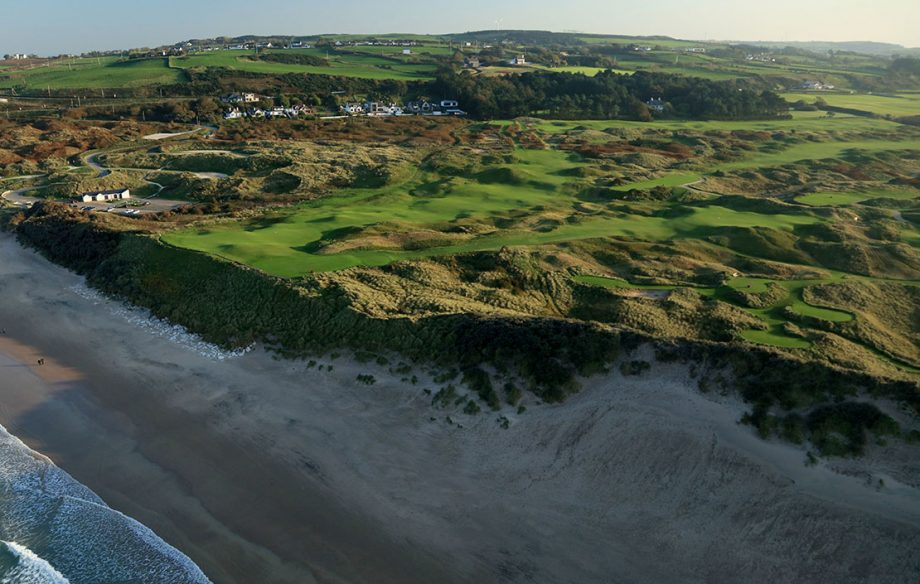Royal Portrush, in County Antrim, is one of the finest golf courses not just in Northern Ireland but the world. Toby Keel paid a visit ahead of the world's best players alighting on this beautiful spot for The 2019 Open Championship.
In 1980, a team of experts began restoring Michelangelo’s ceiling of the Sistine Chapel at the Vatican. It was painstaking work, carried out millimetre by millimetre, with no expense spared in either time or money. Yet even before the 14-year project was complete, the critics’ knives were out: it was crass, simplistic, technically flawed, and completely trampled the artist’s original intention. The controversy rumbles on to this day. Restoration is a tricky business.
In golf, too, restoration is a minefield. Every time The Open returns to the Old Course at St Andrews, the track gets a few tweaks – tiny amends, really, since the place has barely changed in its essentials for over a century. And every time, there’s somebody ready to complain about the updates, grumbling that the Road Hole bunker has been made too big, or too small; or that the new tee on such-and-such a hole ruins the approach angle.
All of this makes it even more remarkable that the updates to Royal Portrush – which will host golf’s Open Championship in July – have been greeted with almost universal acclaim. And rightly so.
The comparison between Portrush and the Sistine Chapel isn’t quite so fanciful as it might initially seem. While even the Antrim club’s most fervent members wouldn’t claim it as one of the Great Works of Man, they will rightly point out that this is one of the finest achievements of golf course design on the planet. The course was regularly ranked in the world’s top 10 by golf magazines across the globe even before the tweaks made ahead of this year’s tournament. And like the Sistine Chapel, it was shaped by the hands of a master: Old Tom Morris, the towering colossus of 19th century golf, first laid the course out on the spectacular dunes of this beautiful coastline. And it was another master who gave the place it’s previous major surgery, back in the 1930s: Harry Colt, the pre-eminent architect of golf’s ‘Golden Age’ who laid out courses including Sunningdale and Muirfield.

A rainbow forms behind the green on the 431 yards par 4, ninth hole ‘Tavern’ with the 418 yards par 4 15th hole ‘Skerries’ in the distance at Royal Portrush Golf Club the venue for The Open Championship 2019 on September 12, 2018 in Portrush, Northern Ireland. Phot: David Cannon/R&A via Getty Images
But while Royal Portush’s Dunluce course, as it’s officially called, was a masterpiece, it had a problem. Or, rather, two problems: the 17th and 18th holes.
After 16 truly magnificent links golf holes, the finishing pair let the track down rather badly. Playing it was like eating the first nine-tenths of a tasting menu created by a chef with three Michelin stars, only to be served Angel Delight for pudding.
It’s not an uncommon problem with links courses, since they invariably start at the flatter land where the clubhouse lies, move out to the more dramatic terrain, then return to the duller stuff. Royal Troon is a perfect example: the opening and closing few holes are entirely forgettable, while the stretch in between as good as anything in the world. Turnberry has a similar problem with its 1st and 18th holes.
At Portrush, however, a solution been put in place by golf architects Mackenzie & Ebert. Those weaker holes were scrapped and two brand new holes built towards the end of the front nine. That’s shunted everything along by two holes, meaning that the old 16th – a fine dog-leg played to a green surrounded by hillocks and gorse – is now the 18th, while the wondrous long par-3 ‘Calamity’ (230 yards across a yawning chasm with a 100ft drop down to the right) is now the 16th instead of the 14th, meaning that nerves and fatigue will play a great role in identifying 2019’s Champion Golfer of the Year.

Royal Portrush has magnificent views out to sea from almost every spot
Even better is the fact that the new holes – the 7th and 8th – are immediately among two of the best on the course. The former is a long par-5 played from an exposed, raised tee – wind will surely play havoc, if it blows – to a fairway tunnelling through dunes, while the 8th brings in to play the same drop in elevation that golfers later have to deal with on Calamity. Both offer precisely the sort of experience which marks out a truly great golf course: you’re constantly presented with shots that you can’t wait to hit.
Tickets for The Open at Royal Portrush have long since sold out – pent-up demand for an Open on Irish soil meant that the entire allocation of almost 200,000 went within days – but practice day tickets are still available. Anyone who loves the game really ought to make the pilgrimage to this magical spot at least once in their lives: Portrush’s course and setting are equally beautiful, and there are a number of other courses and things to see nearby (most notably Portstewart and the Giant’s Causeway) which easily justify a trip of several days.
Green fees on the Dunluce course at Royal Portrush vary from £70 in winter to £205 in summer – see www.royalportrushgolfclub.com for more details, or www.discovernorthernireland.com/golf to find other places to play nearby.

Sporting life: Hickory golf on the South Downs, complete with plus fours and bow-ties
The Goodwood Revival isn't just limited to the motor racing circuit these days – each year, a group of golfers takes

Sporting life: 18 golf courses in the UK that every golfer should play before they die
Roderick Easdale nominates his pick of the best golf courses in Britain and Ireland, with some help from the great

Sporting Life: Stoke Park, the golf club with the famous clubhouse, now has an equally famous coach
Stoke Park is without doubt one of Britain's most striking golf clubs. Now they've brought in one of the world's

Sporting life: Effingham golf club’s restoration has turned the clock back 90 years – and it’s all the better for it
When Effingham Golf Club decided they needed to bring the course up to date, they didn't look forward – instead, they





